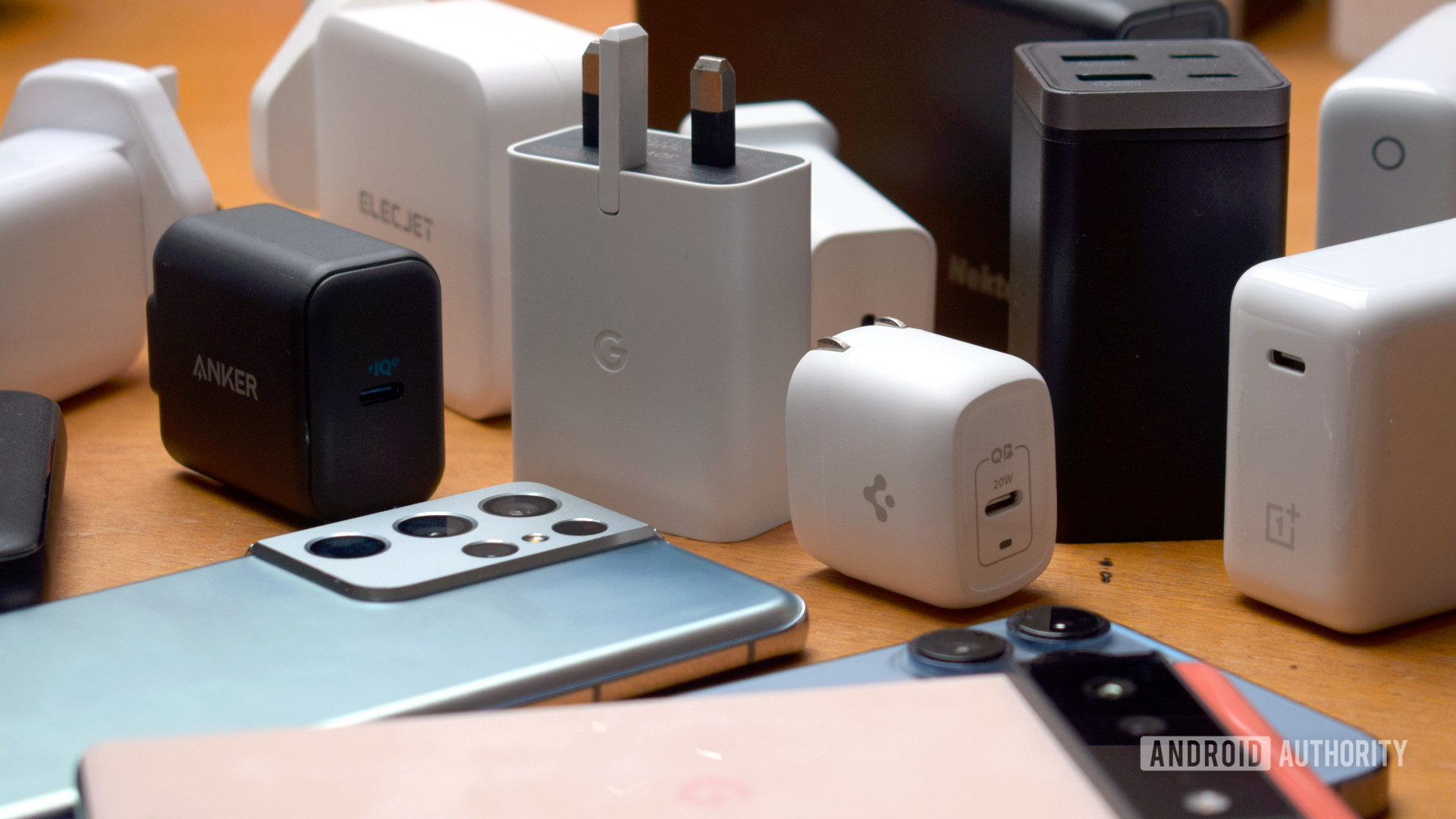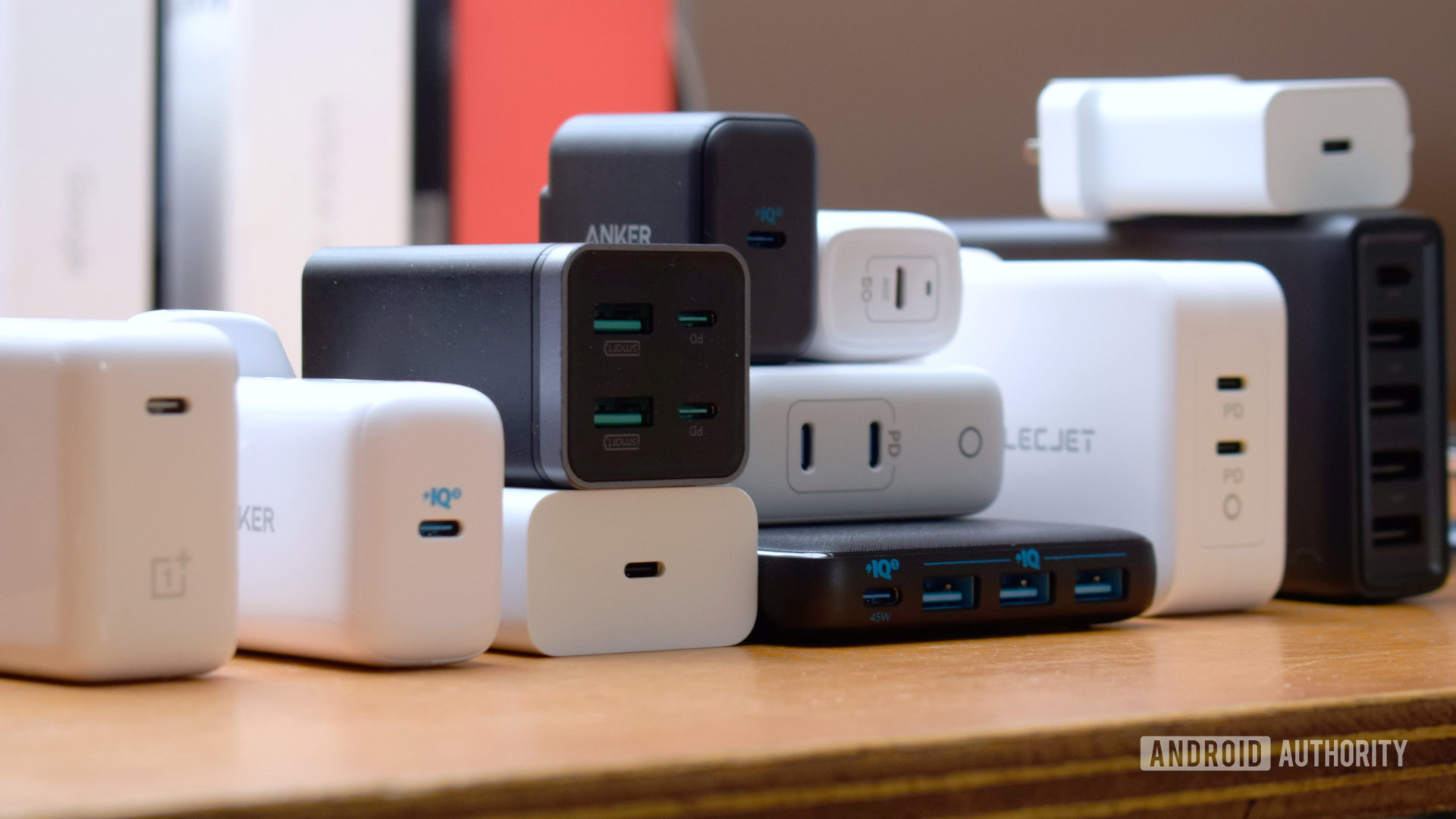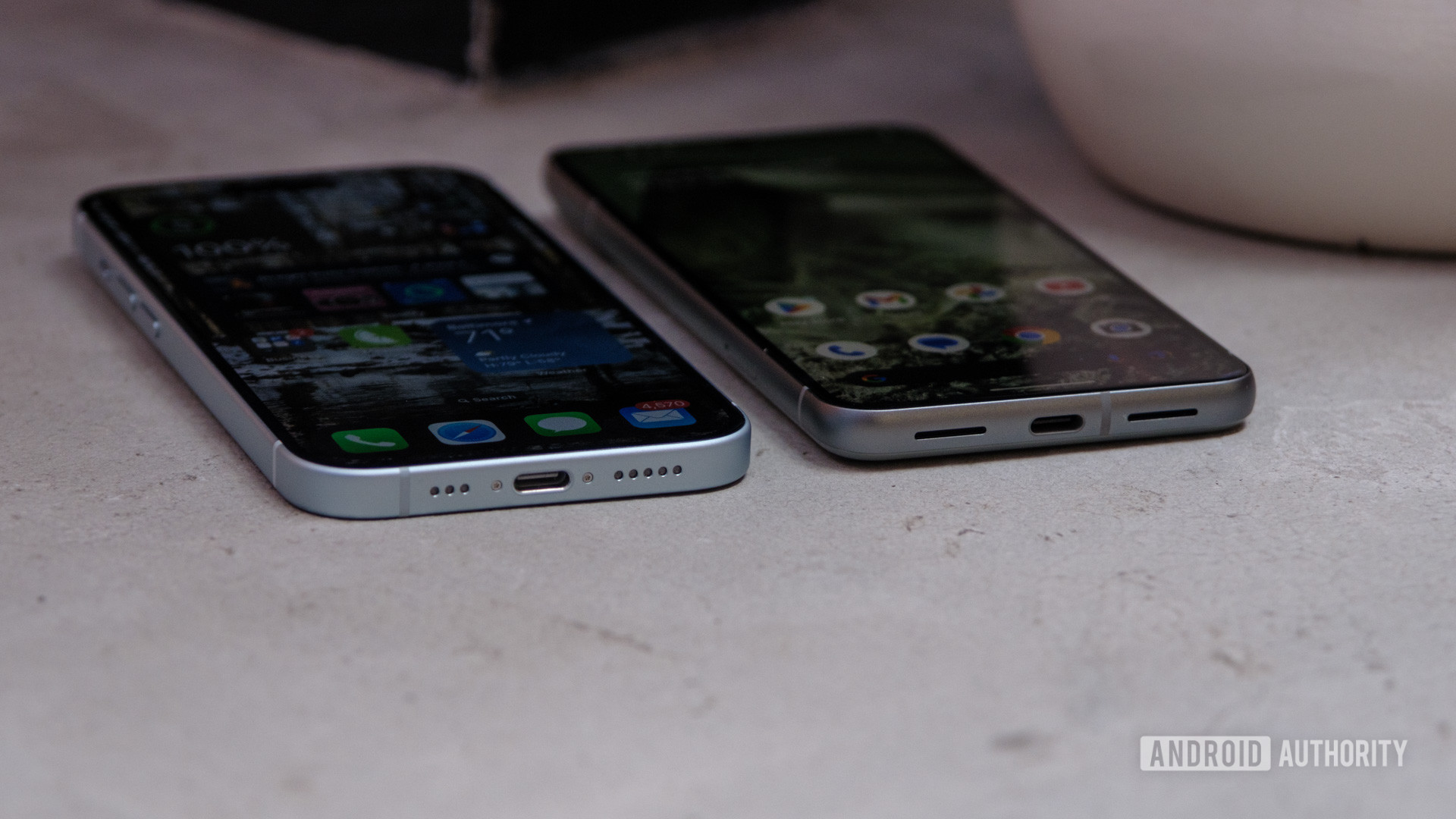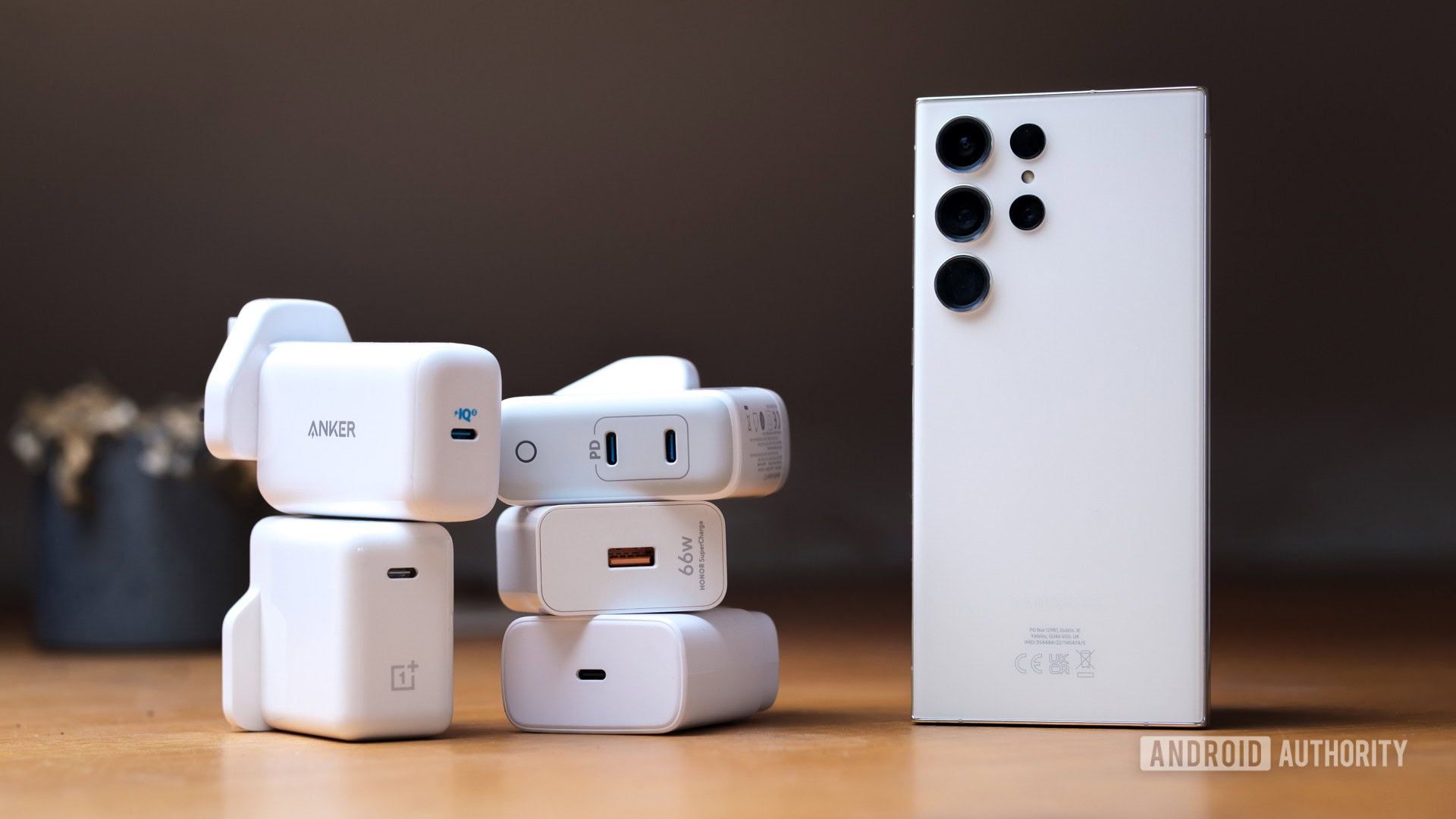Affiliate links on Android Authority may earn us a commission. Learn more.
How to pick the right charger: A practical guide

Picking the best charger for your smartphone and other gadgets has always been a bit of a chore, and the growing trend in handsets shipping without a boxed adapter has only made the process more arduous. The many charging standards, cable types, and brand-specific terminology certainly doesn’t help narrow down your needs.
Charging your phone is simple enough — plug in the USB-C cable to any old plug or port, and you’re off. But is the device really fast charging or powering up as optimally as possible? Unfortunately, there’s no guaranteed way to know. Fortunately, we’re here to help. When you’re done with this article, you’ll be fully equipped to pick out the best charger for your new smartphone, laptop, and other gadgets.
QUICK ANSWER
Here's what you need to know about picking the right charger for your Android device.
- Find out how much power you need in watts (W). This is often listed on a phone's specification sheet or manual. Typically, charging power varies between 18-80W, with some, like OnePlus, exceeding 120W.
- Check the charging protocol supported by your device. You'll need to buy a first-party branded charger if it's proprietary, such as OPPO's SuperVOOC. Universal standards such as USB Power Delivery (PD) open the door to many third-party options.
- Pick a charger matching your device's power requirement and charging standard.
- If you plan to charge multiple devices from a single charger, double-check that it can share enough power on all its ports for your gadgets and that each port supports your required standards.
What charger do you need for an iPhone?
- If you own an iPhone 15 or 16, you'll need a USB-C charger and USB-C charging cable — just like an Android device.
- Have an iPhone 12, 13, or 14? You'll require the standard Lightning charger and Lightning cable.
Keep reading to learn more about our picks for the best chargers you can buy.
JUMP TO KEY SECTIONS
A quick primer on charging your phone

Before we get to the heart of this explainer, we need to touch on a few definitions. For one, we use the terms “wall chargers” and “charging blocks/bricks/adapters” interchangeably to refer to the unit that plugs into your wall from which you can charge your phone. Additionally, USB-C or Type-C chargers refer to chargers with a USB-C port and require a USB-C cable to charge your device. Older chargers may still feature USB-A ports, while older Apple models use Lightning ports on the charger and phone ends.
Smartphones often give you a generic indicator like “fast charging” or “rapid charging,” but that’s not always helpful. The Google Pixel 7, for instance, displays “Charging rapidly” whether you’re plugged into a 9W or 30W charger. Hardly helpful.
When picking out a travel adapter, charging hub, power bank, or wireless charger for your phone, there are two key things to consider. The first is the amount of power you’ll need. Fortunately, manufacturers often list the maximum charging power their device is capable of on the spec sheet.
USB-C can charge everything from headphones to high-performance laptops.
Broadly speaking, smartphones range from 18 to 150W, while tablets go up to 45W. The latest laptops may even offer 240W charging over USB-C. Finally, smaller gadgets like headphones tend to make do with basic 10W charging.
The second is the charging standard required to obtain this level of power. This is the trickier part, as devices often support multiple standards that offer different power capabilities — particularly super-fast-charging Chinese smartphones that use proprietary standards to provide very high power levels. Fortunately, these devices still ship with chargers in the box. Still, you’ll want to know the fallback charging protocol if you plan to buy a multi-charging hub or power bank.
Fast charging requires an adapter with both the right protocol and amount of power.
Generally, there are three categories that every smartphone charging standard fits into:
- Universal — USB Power Delivery (USB PD) is the most common USB-C charging standard for phones, laptops, and more. USB PD comes in a few flavors, but the main thing to note is whether your phone requires the advanced PPS protocol. Qualcomm’s Quick Charge 4 and 5 are compatible with this standard, also making them universal. Qi is the equivalent universal option in the wireless charging space. Some brands use unique names despite their reliance on USB PD, as you’ll find with Samsung’s Super Fast Charging.
- Proprietary — OEM-specific charging standards are used to obtain higher speeds than USB PD. Support is often limited to the company’s own products and plugs, so you’ll seldom find support in third-party plugs and hubs. Examples include OnePlus’ Warp Charge, OPPO’s SuperVOOC, Xiaomi’s HyperCharge, and HUAWEI’s SuperFast Charge.
- Legacy — Some pre-USB-C standards still linger in the marketplace, particularly in lower-powered gadgets and older phones. These include Quick Charge 3, Apple 2.4A, and Samsung Adaptive Fast Charging. These are gradually phasing out of the marketplace but are occasionally used as a fallback protocol for modern gadgets, including Apple and Samsung smartphones.
The magic formula for correctly fast charging your smartphone or USB-C laptop is to buy a plug that supports the required charging standard while providing enough power.
How to find your phone’s correct charging standard

With the above in mind, if your phone uses a proprietary charging standard or comes with an adapter, you’ll receive the fastest charging speeds by using the plug provided in the box — or, failing that, a similar plug that offers an equivalent power rating. Reusing plugs from old devices is a great idea where possible and is always worth a try first.
Ensuring you have the correct charging standard is more of a headache if your phone doesn’t ship with a charger in the box or if you’re looking for something that will play nicely with all of your gadgets. The best place to start your search is on the manufacturer’s spec sheet. There are no guarantees here, though — some list the required charging standard to obtain peak speeds, while others don’t.
See the official spec sheets below for an example of what to watch for.
While these major brands do an okay job, there are some issues even here. For instance, Apple’s product page lists the wireless charging standards but glosses over the fact you need a USB Power Delivery plug for fast wired charging. Meanwhile, Google’s spec sheet lists the required specification but implies you need a 30W charger, when the Pixel 7 Pro pulls no more than 23W from any plug.
If you can’t find mention of a charging standard, it’s a reasonable bet that any phone bought in the past couple of years will support USB PD in some form, although we have spotted that even some flagship phones don’t. Regarding wireless charging, Qi is a pretty safe bet for most modern devices outside of a few exclusively proprietary charging models. While MagSafe-supported iPhone models and the HMD Skyline now support the Qi2 charging protocol, we still await more Android devices to join the club. The protocol adds a ring of magnets but keeps the maximum charging rate at 15W.
How to pick the best smartphone charger

Now that you know the right standard and the amount of power you need, you can cross-reference these specifications with the adapter you have in mind. If buying a multi-port adapter, charging hub, or power bank, you’ll want to ensure that enough ports meet your power and protocol requirements.
Again, some manufacturers are more forthcoming with this information than others. Fortunately, we test charger ports as part of our charger review process to ensure they work as anticipated.
When considering multi-port adapters, note that each USB port often provides different standards and will have to share their power rating when plugging in multiple devices, often unevenly. So check the capabilities of each port, where possible. You’ll also want to ensure that the maximum power rating of your charger can handle the full load you’re anticipating. For example, charging two 20W phones from one plug requires at least a 40W charger or perhaps even 60W for a bit of headroom. Often, this isn’t possible with power banks and even the best portable chargers, so aim for as much power as you can.
USB PD and Quick Charge support covers the majority of phones.
You may also find chargers that refer to GaN (gallium nitride) charging technology. It’s an increasingly popular but far from essential material that helps chargers run more efficiently and cooler while allowing them to be more compact. It’s a nice extra to have, especially for higher-powered adapters.
If you’re struggling to find the correct information or want to cover as many bases as possible, pick a charger that supports USB Power Delivery PPS and Qualcomm Quick Charge. Those standards will ensure you’re covered for the vast majority of devices, old and new. Opting for a 60W model or greater will cover you for everything from phones to laptops. Don’t discount the importance of reputable brands, either. First-party chargers and major third-party brands, such as Anker and AUKEY, are the most likely to implement charging standards, safety features, and multi-device power handling correctly.
What charger do I need for an iPhone?

Apple was reluctant to change its iPhone charging system for the longest time. For those who own an iPhone 12, iPhone 13, iPhone 14, or older, you’ll still need a charger and charging cable with a Lightning port and plug.
If you own an iPhone 15, you’ll be happy to know that your USB-C cable and charger can charge your phone. You can use an Android cable to charge the iPhone 15.
Notably, modern iPhones all support wireless charging. So if you’re reluctant to upgrade your wired charger, an iPhone 15 and iPhone 14 both support
Can I test my device’s charging power?

If you’ve bought a charger but aren’t convinced you’re getting the fastest speeds possible, testing your phone’s charging power can better diagnose issues than simply relying on your phone’s opaque charging indicator. There are a few different ways to do this, some free and some requiring specific hardware.
The simplest port of call is to use an app that gives you accurate battery charging information. AccuBattery and Ampere are popular choices for battery monitoring and list the battery’s current and voltage while charging. Multiply these numbers together to get the power. Inware is an even better choice as it automatically calculates the amount of power.
However, apps can’t tell you the maximum power your device can handle or list the current charging protocol. These methods also rely on the power level reported by software at the battery, which may not be 100% accurate or exactly match the power reaching the device.
You’ll want an in-line USB-C power meter to read the real current and voltage for the most accurate measurements. There are loads of these to pick from online — just make sure you buy one that can handle the power levels you plan to test. We’ve had some good experiences with this 2-in-1 USB-C LCD Digital Multimeter for checking over the basics.
Regardless of your method, remember that charging uses the most power when the battery is closer to empty, typically below 40%. You’ll see much lower power readings when charging your phone with a battery capacity above 75%. If you detect low power levels, try a different cable or USB port, where possible, before buying a new charger.
Now that you’ve read our guide on choosing the best charger for your phone or other devices, you should be able to buy confidently and not worry about whether your gadgets are charging correctly.
Which charger should I buy?

Since many smartphones no longer ship with a charger in the box, here’s a short list of our recommended picks.
- Samsung 45W Super Fast Charging adapter ($27.42 at Amazon): If you want a name-brand option, Samsung’s 45W Super Fast Charging adapter is perfect. The company uses USB Power Delivery PPS, which means you can charge non-Galaxy devices at the charger’s full speed. It also comes with a USB-C to USB-C cable in the box.
- Anker 735 ($45 at Amazon): Need a multi-port adapter to charge multiple devices simultaneously? The Anker 735 can output 65W, enough to charge some laptops, too.
- Google 30W USB-C Adapter ($25 at Google Store): If you need a no-frills smartphone charger that doesn’t cost as much as the other options on this list, consider Google’s 30W USB-C adapter. With its $25 MSRP and USB PD PPS support, it will fast charge most Pixel and even mid-range Android devices as quickly as possible. However, we’d recommend looking elsewhere if you own a high-end Samsung smartphone that supports 45W fast charging.
Note that if you own a Xiaomi, OPPO, or OnePlus device, you must buy a first-party adapter to reach full advertised speeds. That’s because some manufacturers still use proprietary charging technologies. So, while the above adapters will still fast charge your phone, don’t expect sub-30-minute recharge times. Likewise, even the best wireless chargers on the market won’t top up your phone as quickly as with a wired connection.
FAQs
Generally, most Android phones require a USB-C charger and charging cable. Older devices may use a wall charger with a USB-A plug but require a micro-USB charging cable. iPhones, on the other hand, mostly require a Lightning cable and charger. However, from the iPhone 15, Apple has adopted USB-C, so you can use a USB-C charger and charging cable to charge these models.
The iPhone 14 models, and older devices like the 12 and 13, require a Lightning charger and Lightning cable.
No, all USB chargers will provide at least basic levels of power to any phone, although it may be very slow to charge. However, the charger you use and its specifications matter if you want fast charging speeds, as outlined in this article.
Yes. A charger’s wattage determines the maximum amount of power it can provide. This is even more important if you’re planning on charging multiple gadgets simultaneously, as you’ll need enough power for all of them.
No. Based on the supported charging protocols, your smartphone will negotiate and limit the power it draws from the charger.
Yes, it will just take longer.
No, but it also depends. Phones are supplied with batteries designed for fast charging, so fast charging certainly isn’t dangerous. However, batteries may degrade slightly quicker when using fast charging in the long term.